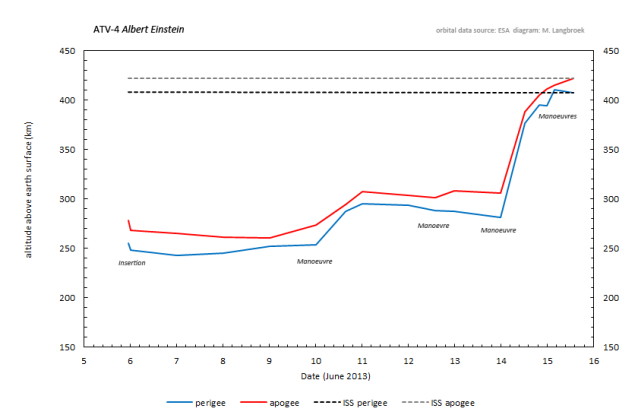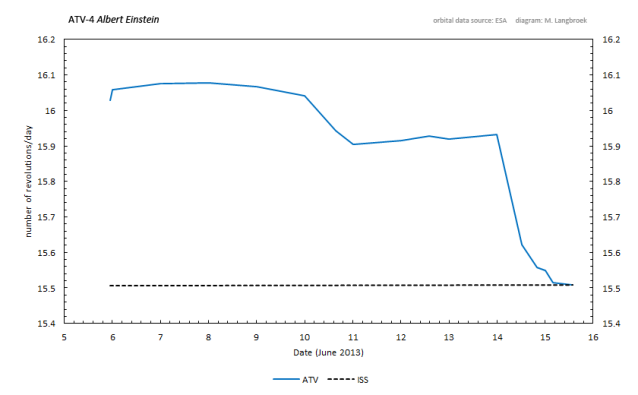Today’s excellent guest post was contributed by Dr Marco Langbroek, an avid satellite tracker, meteor observer and asteroid discoverer (and a stone-age archaeologist in his day job). It was first published in his blog on 7 June. Thank you, Marco!
The ATV Albert Einstein, currently on its way to the International Space Station (see images of passes over Leiden here), does not ascend in a linear fashion. The ascent towards the ISS is conducted in phases.
Below is a diagram showing you how the orbital altitude of the ATV-4 spacecraft has developed during the first few days of its flight and will develop, if everything goes according to plan, over the coming few days until it docks to the ISS on 15 June. As the orbit of the spacecraft is not neatly circular but somewhat an ellipse, values for the highest point (apogee) and lowest point (perigee) of the orbit are given.
It might surprise you, but over the past two days [speaking with respect to launch on 10 June – Ed.] the orbital altitude of ATV-4 has gradually come down, not up. You can see this in the diagram above. It concerns a slight orbital altitude decrease of just a few kilometres, no more. This is because the ATV is currently just moving in a parking orbit around earth without major manoeuvring. As a result, the orbit currently slightly decays (it is slowly pulled in by Earth as a result of gravity and atmospheric drag): it is very slightly coming down!
A major manoeuvre to counter this will occur on 10 June, lifting the spacecraft up from approximately 250 km to approximately 290 km altitude. The orbit will then slightly decay to slightly lower altitudes again, as the ATV will again be drifting.
More manoeuvres raising the orbit slightly to counter this orbital decay will occur on 12 June, but the major manoeuvres will be on the 14th and 15th.
These latter are the manoeuvres that will bring the ATV up close to the orbital altitude of the ISS (see diagram above), first bringing it up to approximately 380 km altitude, and then to about 400 to 410 km, and close to the ISS. It will be somewhat in front of the ISS initially, and move closer to the ISS as the orbit is gently raised. A complicated set of manoeuvres then will bring the ATV to the ISS for docking.



 Automated Transfer Vehicle page
Automated Transfer Vehicle page ATV blog archive
ATV blog archive
Discussion: no comments